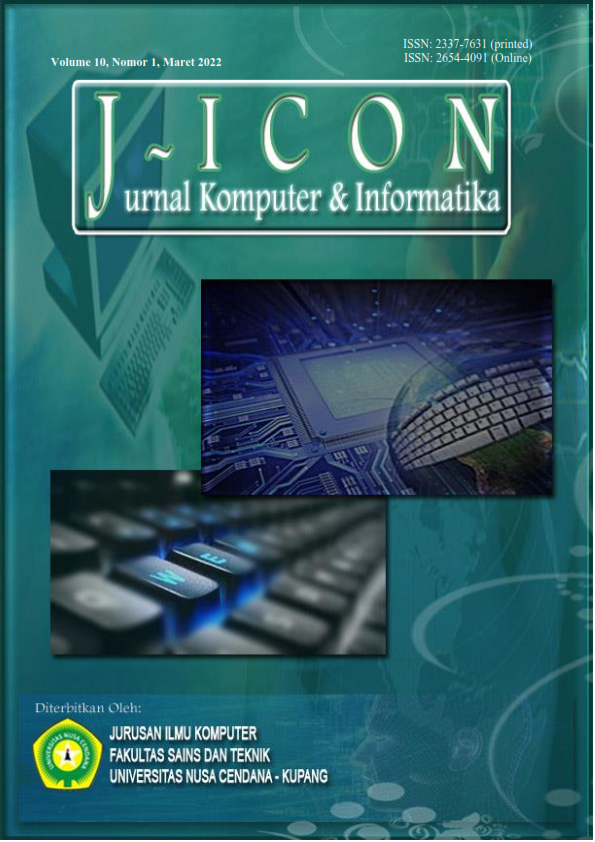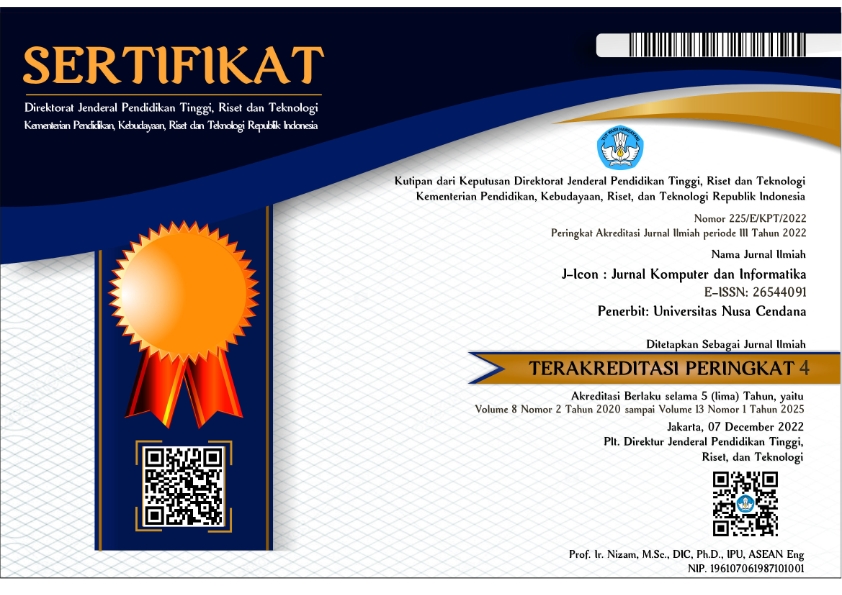Case Based Reasoning to Diagnose Types of Mental Disorders Using the Dempster Shafer Method
Abstract
Mental disorders are disorders of behavior, moods and thoughts that can change a person's behavior differently than usual. Cases of mental disorders obtained from medical record data at the Naimata Mental Hospital (RSJ) in 2019 were 6,157 patients with 2 mental specialists. The lack of a number of mental specialists has caused some mental health programs not to run properly, resulting in a longer recovery rate for mental disorders. In this study, a case-based reasoning system was created to overcome the problem of the lack of mental health workers at Naimata Hospital. The system uses the dempster shafer method for the indexing process and cosine similarity to calculate the similarity value. This system diagnoses 9 types of mental disorders based on 125 symptoms. The output of the system is a diagnosis of the type of mental disorder suffered by the patient. Based on the test results on 90 data on a case basis by dividing the data into 10 folds, the system accuracy for similarity is 49.83% and indexing is 81.01%. The test was carried out another way, by dividing the data randomly into 3 groups, namely 9:1, 8:2 and 7:3 20 times. The first group got an average indexing of 85.21% and similarity 49.22%, the second group got an average indexing of 82.01% and similarity 48.84%, the third group got an average indexing of 78.82% and similarity 48.09%. The average accuracy is low due to the unbalanced case data for each type of disturbance.
Downloads
References
[2] W. A. E. Lestari, A. Yusuf, dan R. D. Tristiani, “Pengalaman petugas kesehatan jiwa dalam menangani orang dengan gangguan jiwa di puskesmas kabupaten,” vol. 2, 2020.
[3] N. W. N. Prasistayanti, D. G. H. Divayana, dan I. M. A. Wirawan, “SISTEM PENDUKUNG KEPUTUSAN DIAGNOSA PENYAKIT GANGGUAN JIWA DENGAN METODE DEMPSTER-SHAFER,” vol. 6, 2017.
[4] D. Hastari dan F. Bimantoro, “Sistem Pakar untuk Mendiagnosis Gangguan Mental Anak Menggunakan Metode Dempster Shafer,” vol. 2, 2018.
[5] silvia A. Gozali dan D. Jollyta, “Metode Dempster Shafer untuk Mendeteksi Penyakit Mental Disorder: Skizofrenia dan Psikotik,” vol. 1, hlm. 104–109, 2019.
[6] L. Sudarmana dan F. Lestari, “Aplikasi Sistem Pakar Untuk mendiagnosis Gangguan Jiwa Schizophrenia,” vol. 3, 2018.
[7] M. Yunita dan T. Widodo, “Sistem pakar diagnosa gangguan jiwa menggunakan metodeNaive Bayes berbasis WEB,” vol. 1, 2021.
[8] L. Rosmalia dan S. Kusumadewi, “Sistem pendukung keputusan klinis untuk menentukan jenis gangguan psikologi pada pasien gagal ginjal kronis (GGK) yang menjalani terapi hemodialisa,” vol. 4, 2018.
[9] M. Z. Kalam, B. D. Setiawan, dan D. eka Ratnawati, “Implementasi metode case based reasoning (CBR) dan K-Nearest Neighbor (K-NN) dalam sistem pendukung keputusan untuk menentukan tingkatan depresi,” 2019.
[10] S. P. Faransyah, “Implementasi case based reasoning menggunakan metode cosine similarity untuk mendiagnosa penyakit pada sapi,” 2017.
[11] A. Aamodt dan E. Plaza, “Case-Based Reasoning : Foundation Issues, Methodological Variations, and System Approaches,” vol. 7, hlm. 33–39, 1994.
[12] H. Pratiwi, Buku ajar sistem pakar. Kuningan: Goresan Pena, 2016.
[13] J. C. Giarratano dan G. D. Riley, Expert System; Principles and Programming. Boston: PWS Publishing Company, 2005.
[14] E. Charniak, Introduction to deep learnig. United States of America: The Massachusetts Institute of Technology, 2018.
[15] A. Riyani, M. Z. Naf’an, dan A. Burhanuddin, “Penerapan cosine similarity dan pembobotan TF-IDF untuk mendeteksi kemiripan dokumen,” vol. 2, 2019.
[16] A. R. Pahlevi, “Aplikasi Sistem Pakar Untuk Diagnosis Penyakit Skziofrenia dengan Metode Ketidakpastian Dempster Shafer (Studi Kasus RS Grhasia),” 2019.
Copyright (c) 2022 Viani Anika Afeanpah, Sebastianus Adi Santoso Mola, Adriana Fanggidae

This work is licensed under a Creative Commons Attribution 4.0 International License.
The author submitting the manuscript must understand and agree that if accepted for publication, authors retain copyright and grant the journal right of first publication with the work simultaneously licensed under a Creative Commons Attribution (CC-BY) 4.0 License that allows others to share the work with an acknowledgment of the work’s authorship and initial publication in this journal.
 Viani Anika Afeanpah(1*)
Viani Anika Afeanpah(1*)




